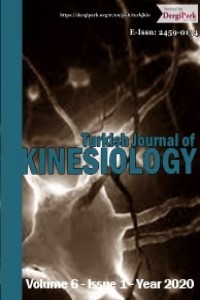The relation between somatotype with aerobic capacity and balance in the boys 11 - 13 years
The relation between somatotype with aerobic capacity and balance in the boys 11 - 13 years
The aim of this study is to investigate the relationship between Somatotype with aerobic capacity and balance in males of 11-13 years. The random-volunteer sampling method was employed in this study to select 90 male students of 11 to 13 years of age. Height, weight, BMI, BF%, the thickness of subcutaneous fat in four areas of the body, the area of the body in two points, the width of the arm and thigh bones, and the aerobic capacity and balance were calculated and somatotypes were determined using Heath-Carter somatotype method. The data were then analyzed through SPSS 18 software, using Spearman correlation method. The results indicated a significant relationship between the aerobic capacity and the values of ectomorphy (r = -0.59), endomorphy (r = 0.69), and mesomorphy (r = 0.57). In other words, the greater the values of endomorphy and mesomorphy got, the greater the record of the 540-meter test got, which means the lesser the aerobic capacity got. However, the opposite was true regarding the value of ectomorphy. Inclination towards endomorph-mesomorph somatotypes is a factor that affects the cardiorespiratory system and balance. Thus, on the one hand, decreasing the amount of fat in individuals with obesity can improve their move and dynamism, and on the other, increasing the weight in thin individuals without increasing their body fat, or more accurately, increasing their muscle tissue can lead to their fitness, which in case results in an increased self-confidence and increased desire and inclination towards exercising and working out, leading to increased efficiency of their physiologic and metabolic systems.
Keywords:
Aerobic capacity, balance, somatotype,
___
- Alonso AC, Luna NMS, Mochizuki L, Barbieri F, Santos S, Maria J, Greve A.The influence of anthropometric factors on postural balance: the relationship between body composition and posturographic measurements in young adults Clinics.2012;67(12):1433-41.
- Avery DF and Wayne LW. Strength and Power for young athletes. Hyman Kinetics.2009;pp 26-28.
- Bruce DG, Devine A, Prince RL. Recreational physical activity levels in healthy older women: the importance of fear of falling. JAmGeriatr Soc.2002; 50(1): 84-9.
- Davlin cd. Dynamic balance in high-level athletes. J of Percept Mot Skils. 2004; 98(3-2):1171-6
- Fisher Abigill, J et al. Fundamental Movement Skills and Habitual Physical Activity in Young Children. ACSM.2004.
- Freidmann J, Elasy T, Jensen GL.The relationship between body mass index and self-reported functional limitation among older adults. a gender difference. J Am Geriatr Soc.2001; 49(4): 398-403.
- Gaeini AA,Rahmani-Nia F, Hosseini SM.The relationship between aerobic capacity, body size and composition and non-athletic female students. Olympic Journal.Iran.2000;3-4(18):57-66.
- Gharakhanlou R, Mahmoodabadi R, Aqaali Nejad H,Mahmoodabadi M. The relation between body composition and VO2max the in boys 11-18 years. Olympic Journal.Iran.2007; 4 (40): 96-85.
- Hosseini Kakhk SA, Safari M and Hamedinia MR.The relation between health and fitness factors in adolescent boys in Sabzevar. Journal of Sabzevar University of Medical Sciences and Health Services.Iran.2010;V18, Issue 1, pp. 66-55.
- Hue O, Simoneau M, Marcotte J, Berrigan Fl, Dore J, Marceau P, et al. Body weight is a strong predictor of postural stability.Gait Posture. 2007;26(1): 32-8.
- Başlangıç: 2015
- Yayıncı: Nurtekin Erkmen
